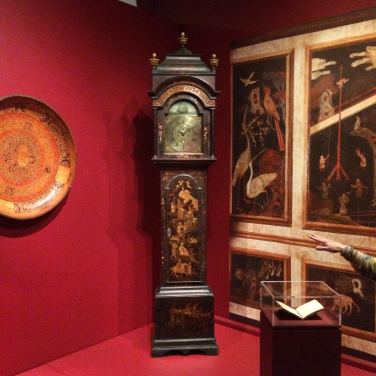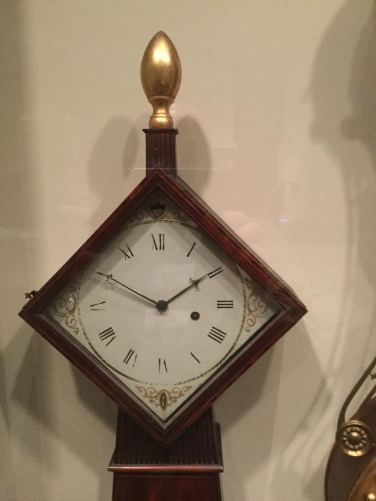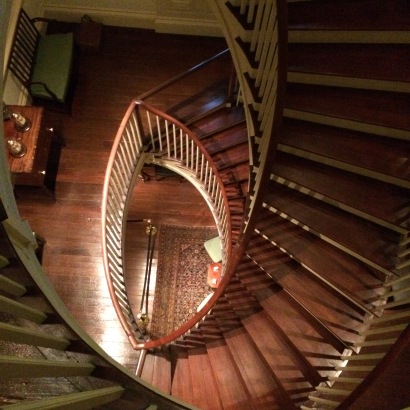From the bench of David B. Lindow:
I recently attended the Ward Francillon Time Symposium. It was a great opportunity to see some old friends, renew some acquaintances, and be introduced to some interesting and talented people I had not yet met. It was the first of these that I have attended so I didn’t quite know what to expect; however, given the list of presenters my expectations were high, and coupling this with it being held at Winterthur even my high expectations were blown away. Bob Frishman put together the program, and I think he outdid himself with it. He has certainly set the bar high for next year at the Boston Museum of Fine Arts where the topic will be Horology in Art.
The focus of the symposium was the collection of clocks and watches at Winterthur. The collection at Winterthur is predominantly period Americana with the occasional European piece that adds to the interpretation of the Americana. With this, they have many examples of the work produced by so many American clockmakers whose names belong to the Pantheon of great American craftsmen.
On top of the list of great presenters Winterthur has two special exhibits going as well. One was “Made in the AmericasP: The New World Discovers Asia” which demonstrated the Asian influence on early Americana, especially from New England. Learn more here. The other special exhibit was “Striking Beauties: American Shelf Clocks and Timepieces,” which featured 16 American domestic wall, shelf, and bracket clocks. These exhibits alone are worth a trip to Winterthur if you haven’t seen them. I will feature more on the clocks in these exhibits below.
The list of speakers was stellar, and from the standpoint of one involved in restoration and conservation as well as reproducing modern versions of these artifacts the information was invaluable. I will touch on some of the highlights. One of the venerated names on the roster was Charles Hummel, author of the book With Hammer in Hand which recounts the work and shop of the Dominy family of clockmakers which made both cases and movements. There is a permanent exhibit on the second floor of the museum devoted to them. The Claggett family of clockmakers from Newport, RI made some of the finest clocks seated in some of the finest cases America ever produced, and Frank Hohmann III and Don Fennimore covered that topic well. For me one of the most practically useful lectures of the symposium was from Mark Anderson who laid out the cogent and rational approach that was taken for the conservation of the case of the Peter Stretch clock that Winterthur purchased a few years back – view the Stretch Clock here.

Mark laid out what was done to the case and why, and explained the approach to creating missing parts that would match the rest of the composition and how they were incorporated in a non-invasive and reversible way. Perhaps the most useful part of the lecture was when he explained their approach to getting down to the earlier layers of finish to bring back the look the maker intended without wiping out original finishes. The clock looks fantastic as a result.
Lisa Minardi gave a lecture entitled “New Discoveries in Pennsylvania Clock Cases and Painted Dials.” While she filled her time with a lot of useful information the most fascinating part of the lecture to me was the information about how pewter and sulfur were used to make inlay in many Pennsylvania clocks of the period. Although I’ve seen many of these cases along my journey in clock restoration I’d never been introduced to the techniques. As a restorer her information on this as well as dials and other things was invaluable.
Robert Cheney, who never disappoints, explained how clocks of the period were manufactured (more information on this topic is available in the April 2000 Antiques magazine) and David Wood gave a lecture on “Diamond Head” timepiece which was fascinating from the standpoint that it very well could have predated the ubiquitous “Patent Timepiece.” John Snellenburg spoke on the Dubuc George Washington French clocks and the history of French clockmaking leading up to them.
From the standpoint of the restorer/conservator there was so much information at this conference it’s impossible to list in a blog post. In addition to what’s above there were lectures on Simon Willard’s clocks, Delaware clocks, the engraving techniques of David Rittenhouse, the Riggs Watch Co., Eli Terry wooden movements, and much more. In addition, though, for the symposium Winterthur put together a special 2 hour tour of all the clocks in on display in the house. With doors open, lights turned up, and many of the clocks running this was a very special treat. Below are highlight of that tour with links to their website.
French “George Washington” clocks by Dubuc featured in Jonathan Snellenburg’s lecture. Notice the engine turning on the dial.
George Jones, Wilmington

|

|
Perhaps the most famous of all American clockmakers, no great collection would be complete without an example of Simon Willard’s work. This one has an especially nice label.
|
This is a clock by Gowan Brown, Boston. He was one of the earliest makers from that city. It is in a Japanned case that is part of the “Made in Americas” exhibit that interprets the Asian influence early American furniture.
Some clocks from the “Striking Beauties” exhibit, a Rueben Tower, Thomas Claggett, and the diamond head is a Janez Baldwin. The two floor clocks are “dwarf” clocks or 1/2 scale.
Though not related to horology or ornamental turning this oval staircase is an intriguing as it is rare. Henry DuPont had it made as a surprise for his wife when she left for a short time putting the carpenters under a strain. They’d never built an oval staircase and didn’t know how but Henry told them they’d figure it out. Indeed they did, and it is one of the most magnificent features of the house.































Thanks very much, David, for posting this great description of a great event. It was worth the two years of my volunteer work putting it all together, and I expect that next year’s symposium I am running at the Boston Museum of Fine Arts will be even more amazing, especially given its unique and groundbreaking theme of “Horology in Art”. Hope to see many of you there!
LikeLike